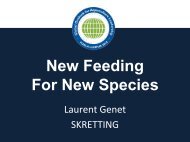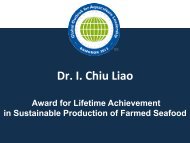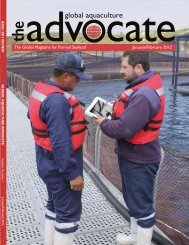May/June 2010 - Global Aquaculture Alliance
May/June 2010 - Global Aquaculture Alliance
May/June 2010 - Global Aquaculture Alliance
You also want an ePaper? Increase the reach of your titles
YUMPU automatically turns print PDFs into web optimized ePapers that Google loves.
Harvest size (shrimp/kg)<br />
Farm gate value (bht/kg)<br />
Cost of production/kg (bht)<br />
Profit/kg (bht)<br />
Profit (%)<br />
Pond preparation<br />
Postlarvae<br />
Feed<br />
Probiotics<br />
Labor<br />
Electricity, fuel<br />
Maintenance<br />
Depreciation<br />
Miscellaneous<br />
Table 1. Performance parameters for Lamae Farm.<br />
Pond number<br />
Culture area (ha)<br />
Species<br />
Annual cycles<br />
Stocking density (shrimp/m 2 )<br />
Harvest size (g)<br />
Yield (kg/ha)<br />
Survival (%)<br />
Growth rate (g/week)<br />
Feed-conversion ratio<br />
set up to retain pond sludge removed<br />
during and after harvests. Crab and bird<br />
barriers were constructed, and many<br />
farms invested in plastic liners to separate<br />
water from soil. The risk of pond failure<br />
was reduced, and pond productivity<br />
increased.<br />
Table 2. Profitability of Lamae Farm.<br />
More From Less<br />
The year 2009 was a good one for<br />
Thai shrimp farmers, with crop failure<br />
rates less than 2%, pond survivorship<br />
above 85% and growth rates that enabled<br />
farmers to harvest shrimp at a size of 60/<br />
kg in less than 90 days with feed-conversion<br />
ratios of less than 1.3.<br />
Thailand harvested around 563,000<br />
mt of shrimp from 52,000 ha of culture<br />
ponds in 2009 – an increase of 126%<br />
from 38% less pond area when compared<br />
to 2002. Likewise, aquaculture worldwide<br />
will harvest over 2.3 mmt of shrimp, a<br />
76% increase over 2002.<br />
While the world greatly increased the<br />
supply of shrimp, the National Marine<br />
Fisheries Service reported that consumption<br />
in the United States increased from<br />
1.45 kg/person in 2002 to approximately<br />
1.86 kg in 2008. This was a 28% increase<br />
in demand.<br />
The supply increase was much greater<br />
2002 2009<br />
6<br />
8.5<br />
P. monodon<br />
1.80<br />
65<br />
16.5<br />
6,640<br />
62<br />
0.95<br />
1.73<br />
2002 2009<br />
60<br />
188.0<br />
174.4<br />
13.6<br />
7.8<br />
Table 3. Production costs at Lamae Farm (%).<br />
71<br />
112.5<br />
89.7<br />
22.8<br />
25.4<br />
2002 2009<br />
23.0<br />
9.1<br />
28.5<br />
10.3<br />
6.4<br />
7.0<br />
2.8<br />
8.0<br />
4.9<br />
14<br />
18.5<br />
L. vannamei<br />
2.95<br />
116<br />
14.2<br />
15,136<br />
91<br />
1.16<br />
1.34<br />
4.7<br />
6.9<br />
51.0<br />
5.4<br />
6.2<br />
12.7<br />
3.6<br />
6.8<br />
2.7<br />
than the demand increase. Therefore,<br />
would this not be a better explanation for<br />
the decline in world shrimp prices and<br />
lower retail prices for United States consumers?<br />
The reason for the increase in supply<br />
was not that Thailand and other shrimpgrowing<br />
nations started using underpaid<br />
“slave labor” in 2002. In fact, the transition<br />
to the more sustainable, higher-productivity<br />
technologies required both<br />
technically competent and professional<br />
aquaculturists, and the serious investment<br />
of additional capital by farmers.<br />
Cost Efficiency<br />
After the introduction of white<br />
shrimp, Lamae Farm acquired neighboring<br />
ponds and increased the number of<br />
culture ponds to 14 with an area of 18.5<br />
ha. The farm produced 806 mt of shrimp<br />
from 41 harvests in 2009 with no pond<br />
failures (Table 1). Costs records at the<br />
CPF accounting department showed an<br />
average cost of production at Lamae of<br />
89.7 baht/(U.S. $2.67)/kg for 2009 – a<br />
48.5% cost reduction from 2002.<br />
Figure 1 illustrates the effect of<br />
changing to domesticated disease-free<br />
shrimp and subsequent genetic selection<br />
programs on cost of production. This is<br />
at a time when there has been an increase<br />
in the unit costs of both feed and energy.<br />
But the gain in efficiency has offset the<br />
increase in unit costs. Feed and energy<br />
represent 64% of the current cost in producing<br />
shrimp, whereas labor represents<br />
only 6% of the cost (Table 3).<br />
Cost efficiency has been driven principally<br />
by the increased growth rate potential<br />
of the shrimp, which has resulted in<br />
higher survival rates and lower feed conversions.<br />
The dramatic decline in pond<br />
preparation costs resulted from increased<br />
management efficiency. reducing the<br />
amount of fallow time between crops from<br />
73 days in 2002 to 18 days in 2009.<br />
Wage Factor<br />
Labor is only 6% of total costs, but<br />
does this indicate the laborers are “barely<br />
being paid”? Lamae Farm employees 21<br />
staff members and laborers. In 2009, the<br />
average cost per employee to the farm<br />
was U.S. $573/month, of which each<br />
employee received $510. The minimum<br />
wage for this area in Thailand is 160 baht<br />
(U.S. $4.77)/day. If a worker is employed<br />
25 days in a month, this represents a<br />
take-home pay of about $120.<br />
Employees at Lamae Farm feel<br />
rewarded both by their job-related<br />
accomplishments and the financial compensation<br />
they receive. By American or<br />
European pay standards, their income<br />
may appear lacking, but in the context of<br />
the Thai cost of living, theirs is considered<br />
a very good livelihood.<br />
But what if Western Hemisphere wages<br />
were paid at Lamae Farm? Could the farm<br />
still be profitable selling into today’s world<br />
shrimp market? The answer is yes.<br />
If Lamae paid an average monthly<br />
wage of U.S. $2,500, the cost of production<br />
would increase to 108 baht (U.S.<br />
In combination with improved stocks,<br />
tighter biosecurity at farms and hatcheries<br />
has led to higher survival and<br />
better animal health.<br />
Figure 1. Production costs for 60/kg shrimp in Thailand.<br />
$3.22)/kg. The average selling price the<br />
farm received in 2009 was 112.5 baht/kg.<br />
Realize, however, that under a scenario<br />
where the farm paid Western wages, the<br />
industry would reduce the amount of labor<br />
by increasing the mechanization of both<br />
feeding and harvesting.<br />
True Benefits<br />
The true cost of Thai shrimp is clearly<br />
based on technology and not lowly abused<br />
or slave labor. Shrimp farming in Thailand<br />
has provided hundreds of thousands of<br />
well-paying jobs that resulted in a net gain<br />
for Thai society. Many people have gained<br />
educational opportunities and thus a better<br />
place in society through the profits of Thai<br />
shrimp farming.<br />
Slavery was abolished by King Chulalonghorn<br />
more than 100 years ago, and in<br />
2008, newly enacted anti-trafficking laws<br />
that carry heavy penalties were enacted.<br />
Thailand is a country with modern laws<br />
for the protection of workers rights that<br />
are enforced when law-breaking activities<br />
are discovered. Today, with the lower<br />
prices paid for shrimp, there is no room in<br />
the industry for gamblers, gold diggers or<br />
non-professionals.<br />
True Cost<br />
Thai shrimp farming is just another<br />
example of why farming is always more<br />
cost effective than hunting. The dynamic<br />
changes that started in 2002 not only<br />
spawned claims that low international<br />
trade prices were due to low wages, but<br />
also charges that the low prices were due<br />
to unfair subsidies by the Thai government.<br />
For that charge, the Thai industry<br />
has had to pay a duty to the United States<br />
since 2004, after the industry began to<br />
adopt more efficient, sustainable and environmentally<br />
founded technologies.<br />
We never question why chicken prices<br />
have fallen, why pork prices have fallen or<br />
why the United States is a leader in corn<br />
products. The answer is technology and<br />
not low-cost, abused labor or a subsidized<br />
industry. The same can be said for shrimp<br />
prices in this modern age of aquaculture.<br />
88 <strong>May</strong>/<strong>June</strong> <strong>2010</strong> global aquaculture advocate global aquaculture advocate <strong>May</strong>/<strong>June</strong> <strong>2010</strong> 89<br />
Production Cost (baht/kg)<br />
180<br />
160<br />
140<br />
120<br />
100<br />
Year<br />
% L. vannamei<br />
% P. monodon<br />
Changing Improving<br />
Species Genetics & Technologies<br />
0 2002 2003 2004 2005 2006 2007 2008 2009<br />
1.5 50.0 80.0 95.0 98.0 99.0 99.0 99.5<br />
98.5 50.0 20.0 5.0 2.0 1.0 1.0 0.5<br />
Alaska Ocean Seafood • Alaska Trawl Fisheries • Alyeska Seafoods • American Seafoods Group • Arctic Fjord, Inc • Arctic<br />
Storm, Inc. • At-Sea Processors Association • Bornstein Seafoods, Inc. • Captain Marden’s Seafoods, Inc. • Glacier Fish<br />
Company • Icelandic Seafoods • Kent Warehouse & Labeling • Kyler Seafood, Inc. • Makah Tribal Fisheries • North Coast<br />
Seafoods Corp. • KONO New Zealand • North Pacific Seafoods, Inc. • Ocean Beauty Seafoods • Ocean Cuisine International •<br />
Offshore Systems, Inc • Orca Bay Seafoods • Pacific Seafood Processors Association • Pier Fish Company, Inc. • Seafreeze<br />
We Support SeaShare<br />
Join the seafood industry’s effort to end hunger. Give to SeaShare.<br />
206-842-3609 • www.seashare.org<br />
Starbound LLC • Stoller Fisheries • Supreme Alaska Seafoods • Trident Seafoods • UniSea, Inc. • Wanchese Fish<br />
Company • Alaska Air Forwarding • Alaska Marine Lines • Bellingham Cold Storage • Burlington Northern and<br />
Santa Fe Railroad • CityIce Cold Storage • Coastal Transportation, Inc. • CSX Transportation • Diversified Business<br />
Communications • Fry Trucking • Horizon Lines • Labeling Services Inc. • Mundt McGregor LLP • North East<br />
Refrigeration Terminals • Northland Services, Inc. • Phillips Seafoods • Western Cartage • Rubicon Resources





